Today I am reviewing another great tenor saxophone mouthpiece made by Phil Engleman at Phil-Tone mouthpieces. I have reviewed quite a few Phil-Tone sax mouthpieces on the site already and am always interested when Phil announces a new mouthpiece model.
Phil-Tone Intrepid Tenor Saxophone Mouthpiece
A couple of months ago he announced that he had stumbled upon a new sax mouthpiece that he was very excited about and that Bob Franceschini was playing on and endorsing called the Intrepid. Here’s a quote from Phil about the new Intrepid sax mouthpiece:
I got a Reso Chamber mouthpiece in recently and started looking at it. When I designed the Sapphire chamber I wanted a piece between a slant and an EB link. I also wanted a thinner table. Later I made the Sapphire special which is a higher baffle version of the Sapphire.
…Little did I know that I made a chamber nearly identical to the Reso Chamber. I’ve been experimenting with rail width, lengthening the window which is quite long on reso chamber pieces and I have altered the baffle design on the Sapphire special. Low and behold its a piece very much like a Reso Chamber.
I just took some more measurements out of curiosity. Chamber depth anywhere my tools will go is dead on…in a weird way. My tip looks wider than the original but after measuring I found it to be in the same. The exterior shape difference of my blank makes it look a little wider at the tip. At this point I would never call it a copy. It wasn’t digitized like the Tribute. However, it more than makes reference to the Reso Chamber tone, color and behavior.
Its always interesting how different baffles behave. Some designs play brighter with a lower baffle than a traditional rollover. Its counter-intuitive but it happens. This piece has a subtle step baffle vs the original sapphire rollover and this piece is significantly brighter in terms of the color surrounding the core.
Next…drop the baffle way down and change its shape from a rollover to a straight baffle with a lesser angle than on a piece like a STM and all of a sudden you have a piece that was brighter than when you have a rollover, clearly it is about baffle type not height. But it is interesting. It seems to then be about moving air across the surface of a plane prior to the drop off into a deeper chamber. -Phil Engleman
The Phil-Tone Intrepid saxophone mouthpiece I received to review is hard rubber. The exterior of the mouthpiece is pretty plain looking. Phil-Tone is engraved on the top of the mouthpiece in white. The word Intrepid is written by hand on the corner of the body of the mouthpiece. The mouthpiece is a 7* tip opening which is around .105.
Phil-Tone Intrepid Tenor Saxophone Mouthpiece
The tip rail is very close in shape to my Rigotti Gold reeds and the table and rails look even and well made. The baffle looks a bit lopsided when looking at it by eye in the light. You can see this in the last picture below. You can see how the right side of the baffle extends a little bit further than the left side making the baffle curve look askew. Although this might bother some perfectionists out there, my experience has been that a slightly crooked baffle can play surprisingly well. In fact, some of my favorite mouthpieces in my collection have baffles that are crooked. (My main gigging metal Otto Link has a very crooked baffle in it that Jon Van Wie put in it and that mouthpiece wails!)
Phil-Tone Intrepid Tenor Saxophone Mouthpiece
I spent about two weeks playing the Intrepid mouthpiece and ended up making two sound clips of it. One is with a Rigotti Gold 3 Light reed. Although the reed felt great on it and it was easy to blow, I had the thought yesterday that perhaps it was a tad soft and I should try a harder reed. I put on a Rigotti Gold 3 Medium and that did the trick for me. The slightly harder reed gave me more to blow against and I could get more volume and a thicker heartier sound up high. I included both clips because I think they both provide good examples of how the mouthpiece plays for me with the different reed strengths.
Phil-Tone Intrepid Tenor Saxophone Mouthpiece
In Phil’s description above he writes that the Intrepid mouthpiece is similar in design to the old Otto Link Reso Chamber. I have never played on a Reso Chamber so I can’t compare the Intrepid to one. I have to admit that I have not heard much if anything about Reso Chambers over the years and always assumed they were probably not very good compared to the Otto Link Slant Signatures that we have all heard about. The only player I have known that played a Reso Chamber was Seamus Blake who I went to Berklee with. I always thought Seamus sounded great on his Reso Chamber although I always considered his sound to be quite dark on it. I believe Ben Wendel plays a Reso Chamber also and he also has quite a dark sound in my opinion.
Phil-Tone Intrepid Tenor Saxophone Mouthpiece
Interestingly enough, I found the Intrepid mouthpiece to be quite bright for me. I was expecting a darker tone from it from my preconceived idea of what a Reso Chamber would sound like but what I got was surprisingly brighter I thought. I emailed Phil about this and he responded:
“Its not a copy…its similar but I tend to add a little punch to them. The baffle profile and the structure is much like the Reso Chamber but the angle of the baffle can be changed for darker or brighter presentation.”
This is not a brightness like a Guardala or similar step baffled mouthpiece but a more spread brightness. Higher baffled mouthpieces will generally have almost a laserbeam type focus to their brightness. When you play, it is like the sound comes out of the bell, hits the wall in one specific spot and bounces back to your ears. What you hear is a tightly wrapped core of focused sound. With the Intrepid it is more like the tone is fatter and more spread. For me, it feels like I would play and the tone would leave the bell and immediately disperse to all corners of the room. In a way, the sound is bigger and fills the room with a big “wash” of sound but it is not as direct and focused as a typical higher baffled mouthpiece if that makes sense.
I think that “spread” big sound gives the tone more character and depth in my opinion. It has a thick substantial sound to it. This is especially true with the 3 Medium reed clip. I felt like the higher register and altissimo had a more substantial thick tone to the notes than the 3 Light reed.
Phil-Tone Intrepid Tenor Saxophone Mouthpiece
With the 3 Light reed I felt like the Intrepid would only give me so much power but with the 3 Medium the power of the Intrepid was multiplied. I had a lot of fun playing up in the altissmo with the 3 Medium reed as the tone didn’t thin out as it does with many mouthpiece. It was full and fat.
The low notes were also very robust and thick in my opinion. I use subtone quite a bit down low and the Intrepid subtoned nicely.
The other thing I loved about the Intrepid is that it had a nice resistance that I could blow against to manipulate and shape the notes. The intonation was also very good.
As far as playing gigs with the Intrepid, I think it would be a terrific mouthpiece to play in a jazz or big band setting for sure. In really loud settings with guitars and synths, I think the spread nature of the tone might make it hard for the Intrepid to cut through in a mix like that. Don’t get me wrong, the Intrepid has plenty of power and brightness when pushed but my experience has been that pieces with a spread tone often times get lost in the mix when fighting with electronic instruments. That being said, Bob Reynolds plays a hard rubber Otto Link and seems to manage in those settings so it could work…….
Phil-Tone Intrepid Tenor Saxophone Mouthpiece
If you like the clips below and the Intrepid mouthpiece interests you contact Phil Engleman via his website at Phil-tone.com. Phil is very knowledgeable about sax mouthpieces and will answer any questions you might have about the Intrepid or any of his other mouthpiece models. Thanks for letting me try the Intrepid Phil!
Phil-Tone Intrepid Tenor Saxophone Mouthpiece- Rigotti Gold 3 Light Reed
Phil-Tone Intrepid Tenor Saxophone Mouthpiece- Rigotti Gold 3 Medium Reed
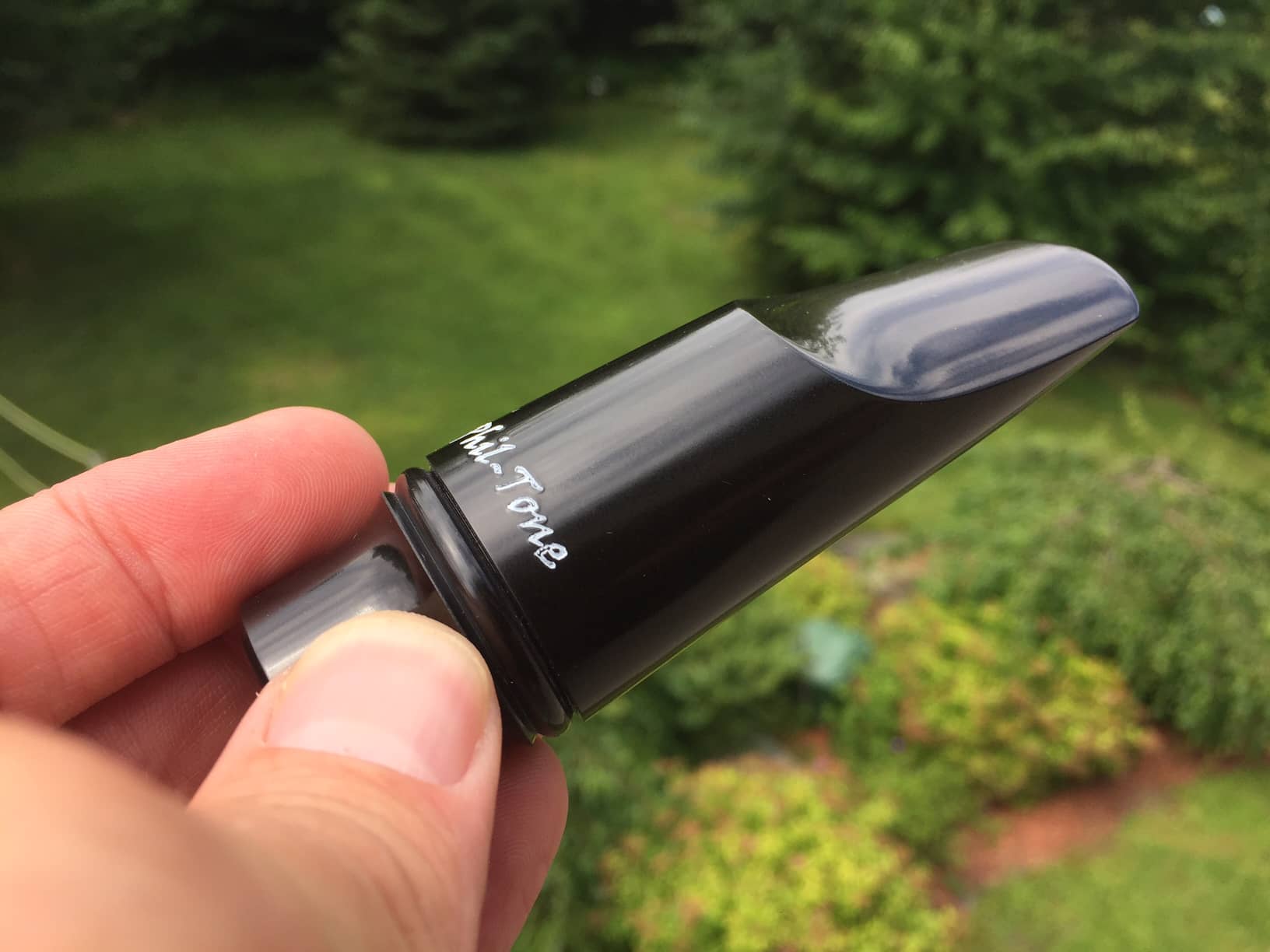
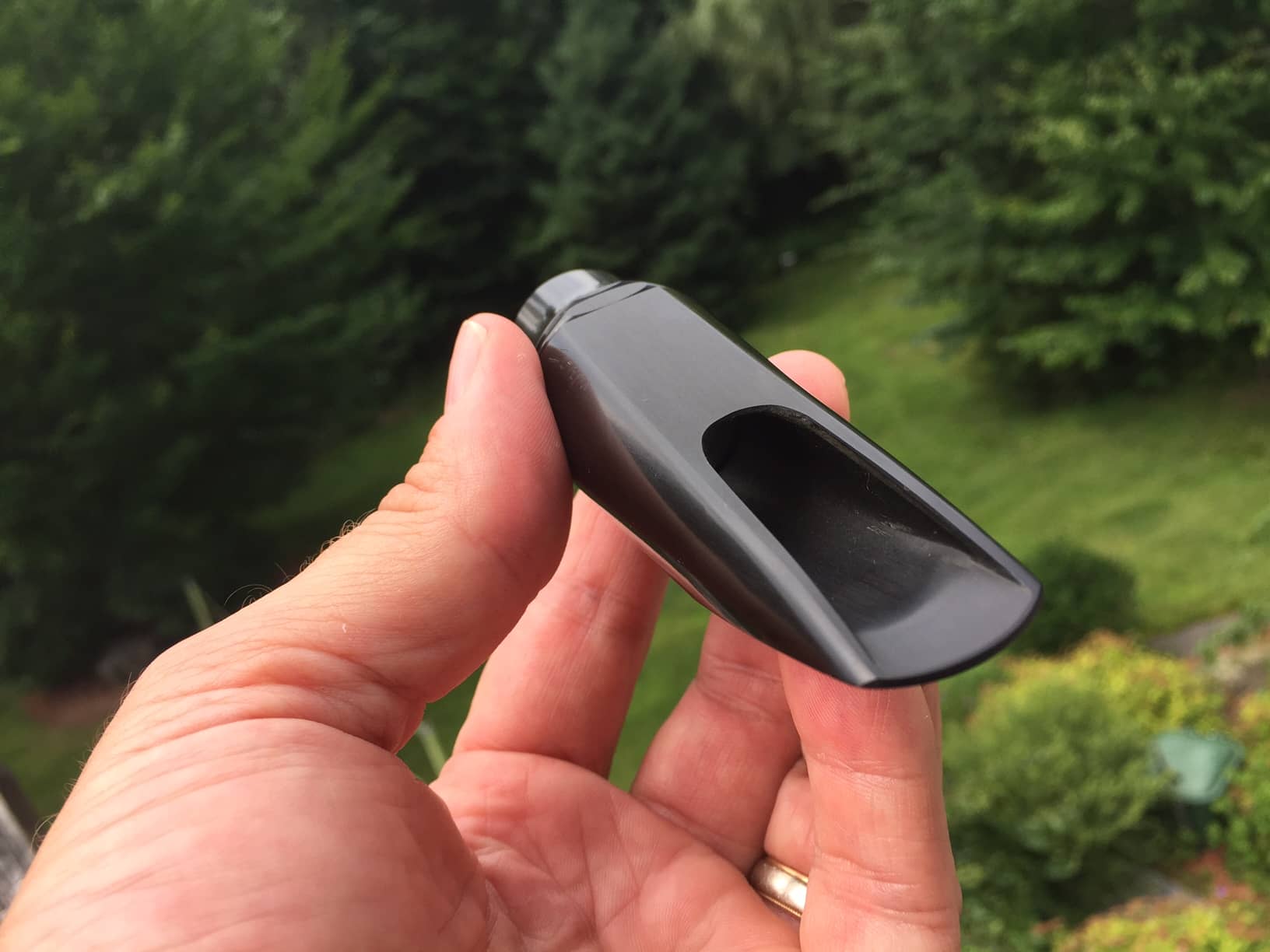
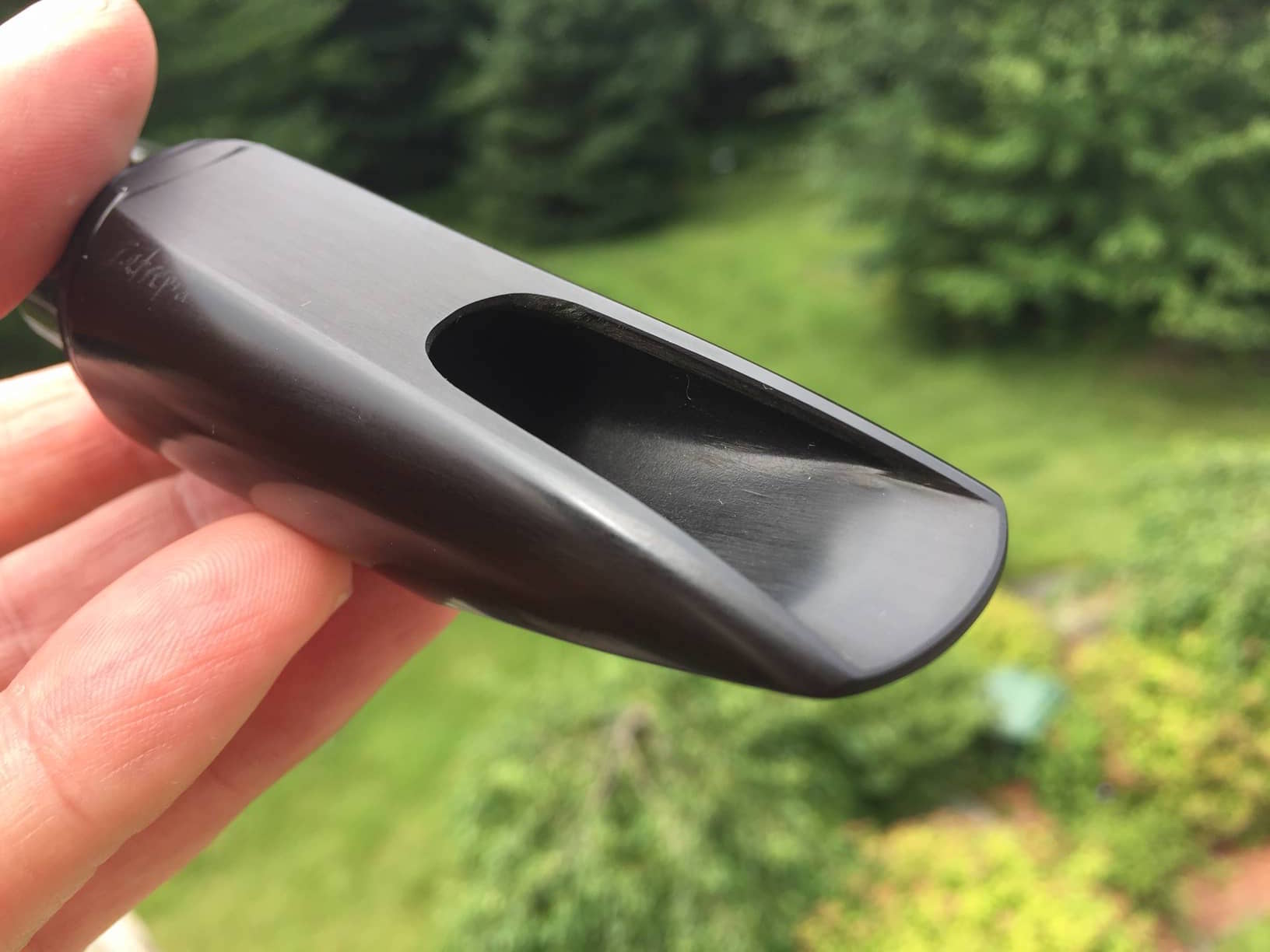
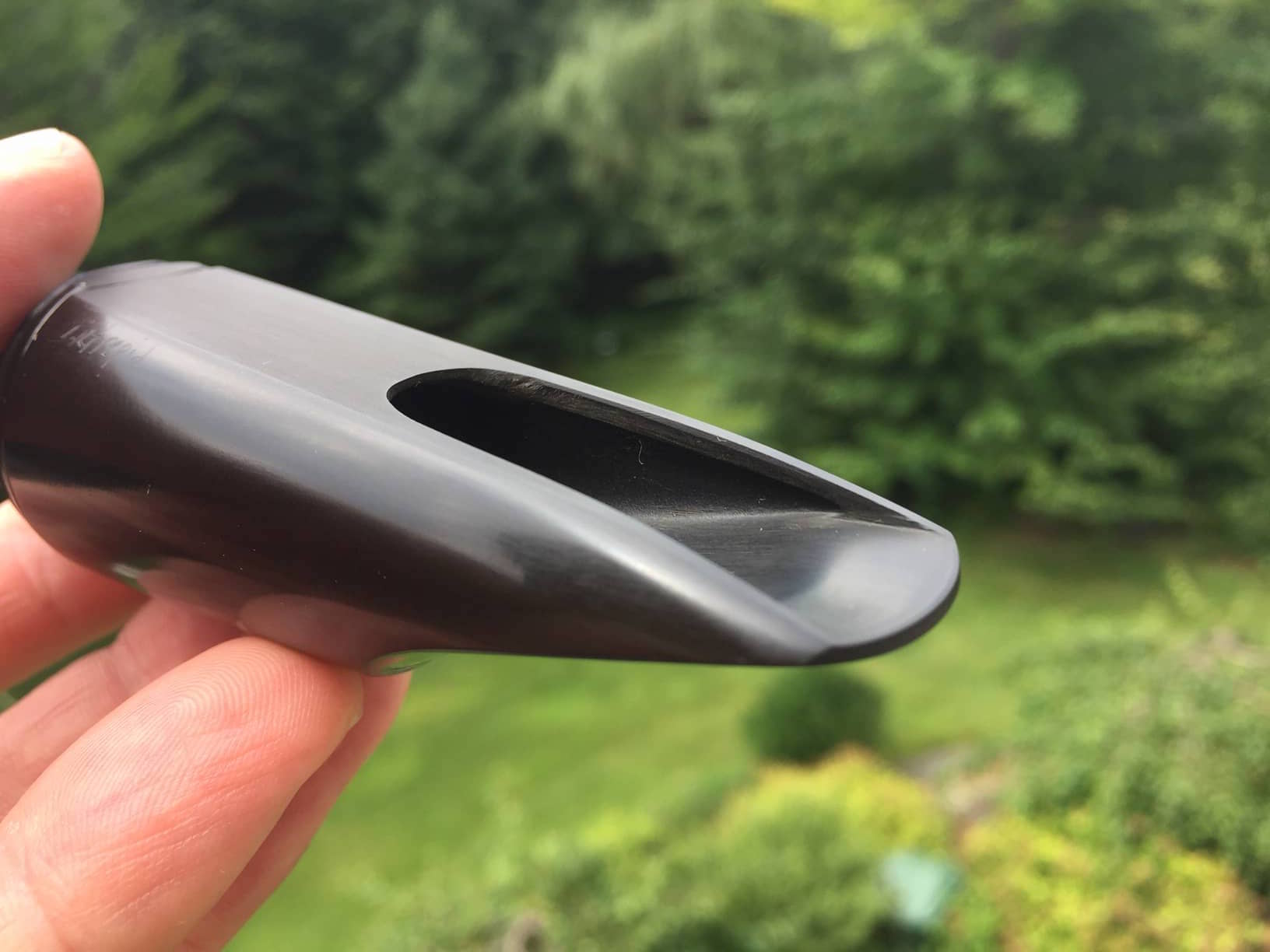
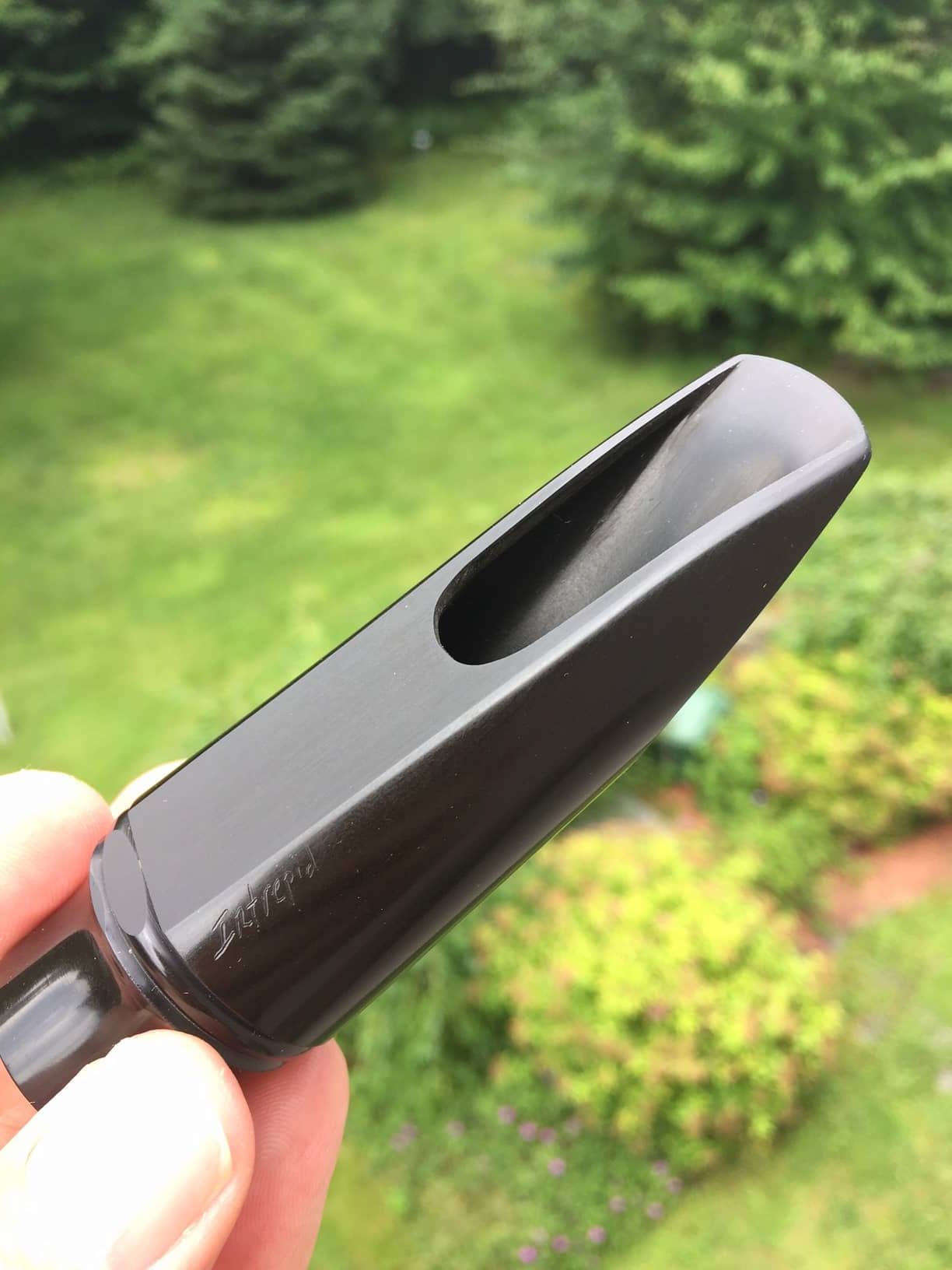
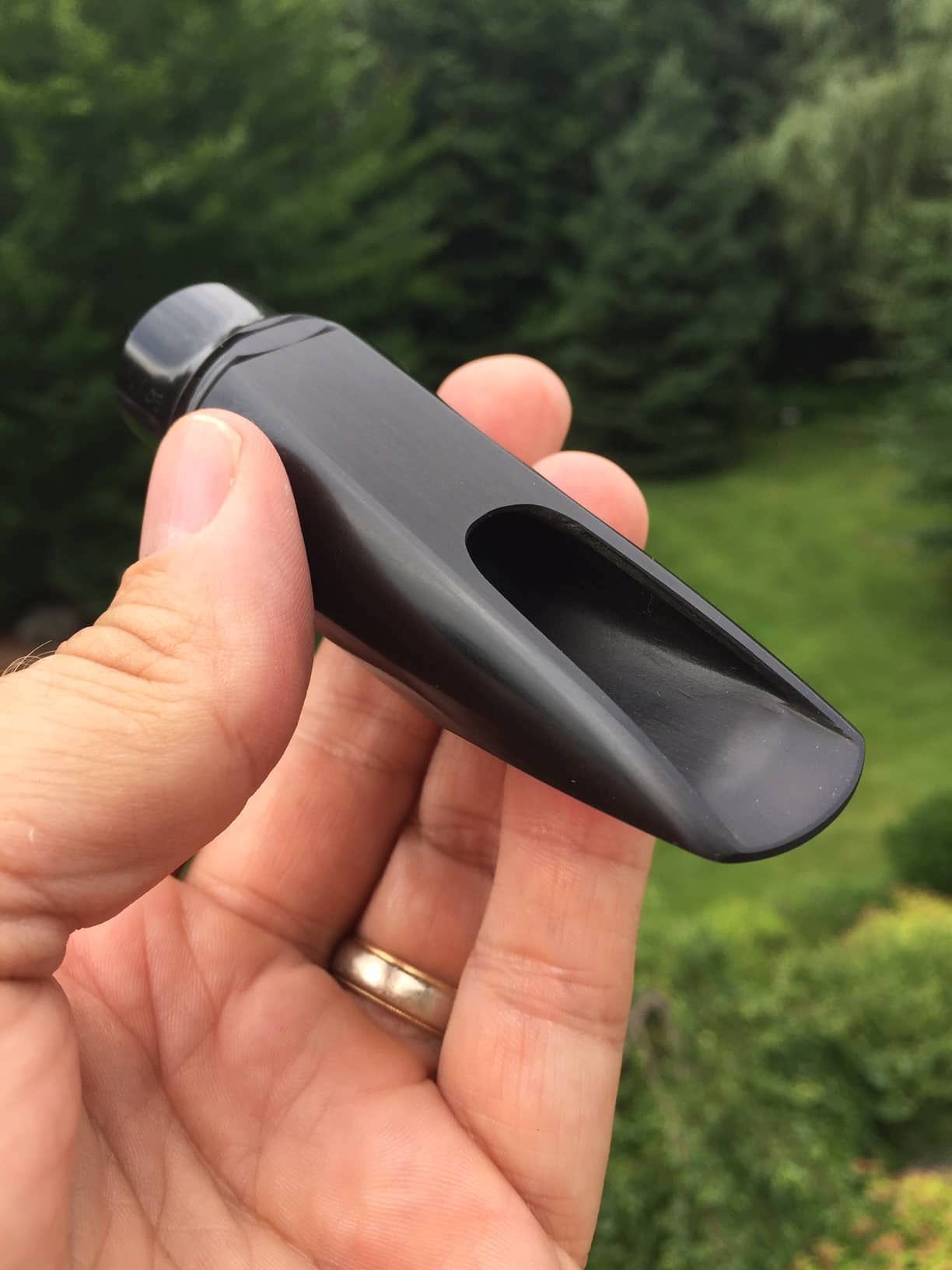
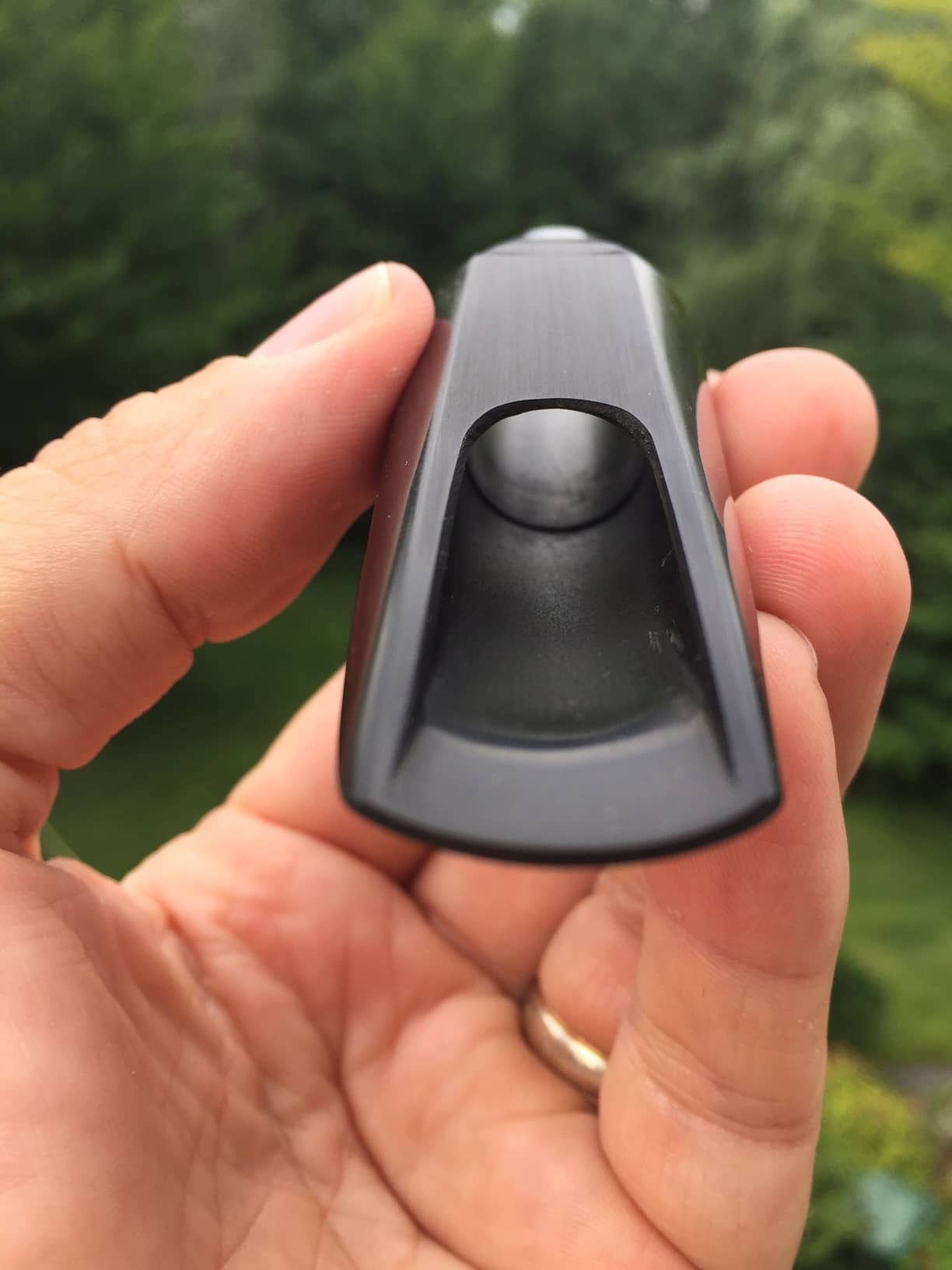



Steve-
I like the way you sound on this piece. It’s maybe a little more compact sounding than some other pieces you’ve tried, in the sense that it has a really nice focus and the overtones seem really nicely balanced. In other words, not too bright, not too dark. It also sounds pretty darn free blowing. Really nice clips. I think I actually preferred the softer reed clip.
Joel if you would like to try the piece let me know
Phil-tone@hotmail.com
Thanks
That’s definitely got a fatness and evenness to it that appeals to my ears Steve. I prefer the grittiness of the slightly harder reed (but that’s my thing). It seems to have a little more zing than I’ve heard on Reso pieces but I am listening through computer speakers – Always hard to tell how it fills a room. I’ve never tried an original Reso myself, although the new Rubber Klum that I tried recently definitely reminded me of that vibe. Actually it sounds quite similar to this. Really fat in the palm keys as well as warm down the bottom end. Sounds quite colourful and flexible. More so than the Sapphire 9 I had Phil make me, but maybe I went out of the sweetspot range on that one.
Steve: They both sound good however I agree w/Joel Frahm, I like it w/the slightly softer reed. When you played the bit of “I Thought About You” it really had a core to the sound, I think it subtoned easier and fatter for you too.
Not to be critical but I notice that when you try a mpc out and switch to a harder reed you tend to play a lot from the middle register to the altisimo. When you play low w/a a harder reed the low Bb’B, C , C# tend to bark out. Plus while it will subtone it’s not as fat sounding as the softer reed. I guess it depends on the type of gig you are playing huh.
I’ve heard Semaus Blake play live at GMU. He talked a bit about his Reso Link. According to an article in an old Saxophone Journal by Ralph Morgan the HR Reso Link was made to be an inexpensive version of the Tone Master made in the 40’s. The article gave a whole list of players who played either the Reso or the metal Tone Master Links. The article said what they played and what size they played. Metal Tone Masters were played by guys like Ben Webster, Coleman Hawkins, Georgie Auld, Flip Phillips etc. The only player that I remember using the Reso HR was Bud Freeman. But I do not have the article in front of me. Needless to say Semaus Blake sounded Great on his HR Reso Link when I heard him about 5-6 yrs ago.
Thanks for the feedback Larry. I don’t think the way I played was due to the reed but I listened back to the clip with the 3 light reed and thought it was a bit too laid back and mellow. I didn’t feel like I showed the more powerful side of the mouthpiece so I made another clip to show that and just so happened to use the harder reed. The harder reed does give much more power in my opinion but there are trade offs like you write about. Steve
What sort of ligature do you use? I have this mouthpiece and it is a joy to play!
Brian, On those clips I was using a Francois Louis Ultimate ligature but I have probably 50 ligs in my desk and switch up quite a bit. i find the FL ligature makes the tone a tad darker and more focused in my opinion. Steve
Hey Steve any plans to review Intrepid alto? I would love to hear your thoughts on it.thanks!
would you consider the inrepid darker than the 10mfan classic or merlot darker and more spread i am considering one of these as my next MP, thanks steve
Philipe, I consider the Intrepid, Classic and Merlot to be in a similar category. For me, the Merlot was the darkest, then the Intrepid and I found the Classic a bit brighter than the other two. Steve
Well, we will see what this Phil says LOL,I just ordered one ,,,,Phil-Tones site example sounded good as do all of Steve’s clips. Thanks again Steve. Your examples are great for decisions, all of my choices came from this site, hopefully Phil-tone will be one of my keepers. I hope so! It seems like it hits the lows sweet and spread, the softness is what I am looking for, I have a Woodstone which is a great all around piece and a Gerber which is good for jazz and some med dark, but tears up 50s rock and roll, and of course a Ben Allen reface on an otto link, I might want to pull off a merlot too…….
Hi, Steve, I really like Intrepid and I went to visit Phil’s website, but I do not find indicated the tip opening measures of the various mouthpieces produced. Among these I, perhaps, prefer the Intrepid. Are they built, each model, in a unique opening?
Thanks if you can give me some information, since I use little tip openings (0.081, 0.085) Hopefully, if you know, what is the model produced by Phil that has such tip opening, if produced?
Thanks in advance.
HI, I would use the contact form on Phil’s website and ask if he makes mouthpieces in those tip openings. I don’t know offhand. The ones I have tried were in my tip opening of 7*. Steve
I just order an *8 Intrepid. Phil will make whatever tip opening you want.
You are very kind! Thanks!
Hi Steve, between Sapphire and Intrepid are you in agreement that Intrepid plays better? Between Intrepid and Ken Okutsu Traditional II what do you think? Is there something in the sound of resembling? The Ken Okutsu Traditional II always stands out, as I think?
Giuseppe,
That is a question I can’t answer for you. If you ask me what is the best pizza at my local pizza place I might tell you the one with mushrooms is the best because I love mushrooms. If you hate mushrooms, it won’t be the best for you. You might say the sausage pizza is better. It’s the same with mouthpieces. The Sapphire, Intrepid and Okutsu Traditional II are all great mouthpieces. They all played well for me. There were differences but I can’t say which of the three is the best. I had to send the Sapphire and Intrepid back even though I really dug them because Phil needed them back. I still have the Okutsu Traditional II because Mr. Okutsu was kind enough to let me keep it. I’m thinking of doing a comparison article in the next month of the pieces I have here like I have done in the past but I don’t have a Sapphire and Intrepid here to use for that. I would say to listen to the clips and go with what sounds good to you. You said you had decided on the Okutsu five months ago so I would go with that if you still feel the same. Steve
Steve, thanks for the reply:
You’re right, but at the time, five months ago, I had not yet heard the Intrepid clip; although the Traditional II I like a lot for the volume, the width of the sound and the timbre, and that something I can not explain well, even the Intrepid, although it seems less “voluminous” (I do not know if it depends on the recording) but it has something indefinable in the timbre of the sound that strikes me and I particularly like it; maybe I should try them, even for the most suitable tip opening but, of course, in Italy they are not found.
Important: like you, I also like the mouthpieces that offer a certain resistance in playing them because they leave me the possibility to “shape” the sound; perhaps Meyer, in his way of a cheap commercial piece, has this characteristic?
What do you remember, if you remember, the Intrepid offers more or less resistance than the Traditional II?
Another problem, so I no longer ordered the Ken Okutsu that, kindly, Mr. Okutsu would have built me in any tip opening, is that I have to waste a lot of time in the bank to make a transfer in Yen and I, perhaps because there I worked, I hated the paperwork and the time to lost for the files and the compilation of forms that, if you miss a comma, come back; I do not use credit cards and other modern online payment methods; I’m cut off from the world! Then I start thinking about the posts and how the mouthpiece could get … and complications for the distance. Also it would be good to try first but, in the requested opening, I would not take it back and, anyway, I do not like the files to mail to send items
…
Also Mr. Phil, now in France, to whom I had asked if I could do it in 0.081 or similar, he replied that he can but would recommend 0.090 or 95, for the issue ease. But for me it is also a stylistic problem, not just fatigue.
Both Mr. Okutsu, and Mr. Phil, can not send me the mouthpiece, as I requested for simple convenience, at my home address, with cash payment on delivery!
In this case, more comfortable, I could solve the problem of choice by ordering both the mouthpieces that both I like!
In these months then I had, and I have, important problems at home that do not leave me time to complicate my life! …
How beautiful it was when the shops had everything, you came in, tried, paid and went home happy!
P. S .: for the pizza, for me the best is the “margherita”: tomato, mozzarella and basil; but low, to the Roman way and not high, to the Neapolitan way!
Strange, on American films, I see that when they order pizza, they take one pizza for more people … Does it correspond to reality? Here, we eat one, or more, pizza for each person!
I seem to remember the Okutsu as having a unique kind of resistance that I was really intrigued by and liked a lot. I think that is because it has a concave table. The Phil-Tone pieces have a flat table. The difference in tables just means the reed interacts differently when being played. I remember really digging that aspect of the Okutsu pieces when playing them. As I think about how it felt, maybe the Okutsu was a little more resistant for me in a good way.
As far as your situation, you should really try to open a paypal account. It is pretty painless and works great if you are responsible. In this day and age of internet consumerism, you really have to have a credit card or paypal account in order to shop. The days when you can go down to the local music store and get your stuff seem to be over. Steve
I forgot: for my taste I prefer the clip with the softer reed.
Steve, there’s been a misunderstanding:
among the three mouthpieces, I was wondering what was the best according to your opinion and “for you”, for your tastes, not “for me”. I consider your opinion very reputable and I wanted to see if it corresponded with mine. For me too – and the thing is different because I do not have the possibility to try them directly and feel how they react physically – the idea is that all three are excellent mouthpieces and that they are different and may like more or less according to taste, just as you write.
I was curious to know, given your experience, which of the three you preferred for “your” tastes if you could have only one. But you have already told me that they are all three excellent and different, you can not choose one, even for your tastes, because all three are beautiful for different reasons!
Did I get it right?
I, perhaps, would like to keep them all because all three are beautiful for different reasons, at least hearing them without trying them.
The hard part about answering your question is that I did not have these three pieces at the same time. It’s one thing if you can play each piece next to each other but when the playing experience between them is months or years then it is hard to compare. I honestly don’t know. I have 12 HR pieces right now together in my drawer and if I had to sell 11 and keep one I would have a wicked hard time doing so. Those are the pieces I will use for my comparison clips but even when playing them side by side and listening to the clips it’s hard to pick. I will listen to one and think “I like how bright it is”, I will listen to another “I like how dark it is”, etc……
If I had to pick one I would probably have to pick the one that I think is the most versatile which for me would be the Okutsu Traditional II of the three you mentioned because of how loud and bright it can get. That being said, there is a trade off. I could see only having that piece and missing the character, lushness and darkness of some of the other pieces. I might play a jazz gig on it in a certain room and feel like it is too bright in that room. etc……..For example, My JVW metal Link is like that. It has been my gigging mouthpiece for like 16 years because of it’s versatility BUT when I just play a straight ahead cocktail hour or dinner set it always kind of gets on my nerves because it can get pretty bright when you push it. It still is one of the best pieces for versatility though as I can play a standard and then rip a solo on Respect in a flash if I need to.
Of the three pieces you ask about, for that kind of versatility, I would go with the Okutsu Traditional II. For a piece that leans a little more to the jazz side because it has a little more character and darkness but can still be versatile the Intrepid. For just jazz with no need to rip out a solo on Respect maybe the Sapphire. Hope this helps, Steve
Steve, you were really available and exhaustive at best, thanks for the time you spent for me. I understand the difficulty of remembering the characteristics of the mouthpieces after some time, but you confirmed what I already thought, and this is important because it confirms my pre-existing idea: the Traditional II, particular resistance (as like of butter, if I well remember) and Intrepid a little ‘darker’, fascinated, jazz.
I think that, when I have solved my time problems that do not tear me to breathe, if such mouthpieces still exist, I will act responsibly with paypal (which Mr. Okutsu does not take for “custom” mouthpiece) or else, to buy them both; or, if I have time, I will go directly to Japan and then to France to directly purchase the two mouthpieces … I am joking, in this case; but, if I had the time, I would take advantage to make a nice trip!
Thank you for your site that is very useful for saxophonists.
Thanks again and … good pizza (Roman)!
It’s just the impression I get for the Intrepid: subtly sophisticated and fascinating, “… that leans a little more to the jazz side because it has a little more character and darkness…” as you write. More character!
Hey Steve, I now have 4 mpcs by Phil. The Rift Alto, which is my main Alto piece. It’s absolutely a killer, and 3 Tenor mpcs: The Equinox, the Intrepid and the Isotope I seem to be covering the spectrum, lol). For a straight up Jazz gig it’s the Intrepid. When I bought the Intrepid the Equinox took a back seat, however, I pulled it out today, put on a Rigotti 2 1/2 and was just amazed by its dry compact tonal character. I’m thinking of using it as my main tenor mpc for teaching but, it’ll probably make it on stage again real soon. As for the Isotope I can’t seem to get the perfect reed match for it. Right now I’m using a Forestone Onyx but I don’t think that’s where I’ll end up. And yes it’s in your face contemporary, but it’s competing against my Theo Wanne Durga for playing time . The Durga has been winning out. But the Isotope is still a great piece, I just need to be more particular on reed selection. Phil does an awesome job and it has been your reviews which pointed me in his direction. Thanks so much.
Steve: I have an 8* Intrepid coming to me from Phil. We’ll see how it plays. I hope it plays as swell as the one you’re playing on the clips above. I’ll let you know once I receive it.
Ciao,
Larry W